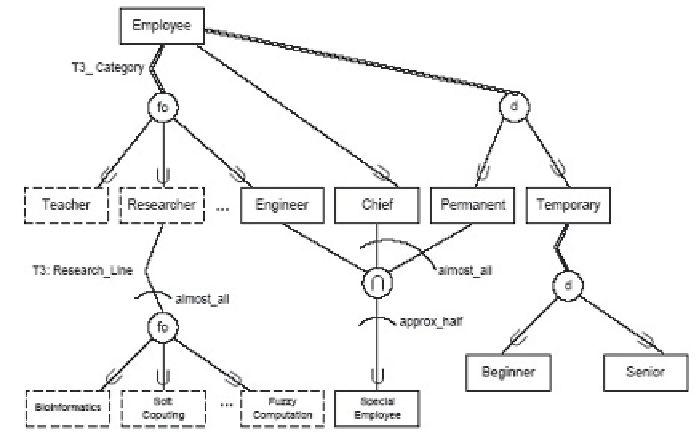Database Reference
In-Depth Information
Figure 11: Examples 9 and 11. Three fuzzy attribute defi ned specializations, two fuzzy
overlapping specializations and fuzzy constraints in a shared subclass
CONCLUSIONS AND FURTHER RESEARCH
Fuzzy logic allows us to bring the operation of information systems closer to the work-
ing methods of humans. People control fuzzy concepts very often (terms like “almost all”,
“the majority”, “approximately 8”...), which include a certain vagueness or uncertainty and
which traditional information systems do not understand, and therefore cannot use.
Fuzzy databases (Galindo, 1999; Medina et al., 1994; Petry, 1996) have also been
widely studied with the following main objectives: fi rstly, to allow the storage of imprecise
or fuzzy data, and secondly, to allow the possibility of imprecise or fuzzy queries, using
the existing data (whether imprecise or not). Traditionally, the application of fuzzy logic to
databases has paid scant attention to the problem of conceptual modeling.
The extension of the EER model (Connolly et al., 1998; Elmasri et al., 2000) for
dealing with fuzzy data has been studied in some publications (Chaudhry et al., 1994,
1999; Chen & Kerre, 1998; Ma et al., 2001; Zvieli & Chen, 1986), but these approaches
are partial: They study or extend only some aspects or, in some cases only one aspect of
EER model. For example, none of them refers to the possibility of extending constraints
by using the tools offered by fuzzy sets theory. In this context, FuzzyEER model (Galindo
et al., 2001b, 2003, 2004; Urrutia et al., 2002a, 2002b, 2003) is a tool for fuzzy modeling,
based on EER model.
In this chapter, we have defi ned the FuzzyEER aspects related with aggregations and
specializations: fuzzy aggregations, fuzzy degrees in specializations, fuzzy completeness
constraint on specializations, fuzzy cardinality constraint on overlapping specializations,
fuzzy disjointed or overlapping constraints on specializations, fuzzy attribute defi ned spe-
cializations, fuzzy constraints in union types or categories and fuzzy constraints in shared
subclasses (or intersection types). The defi ned constraints can be represented using fuzzy

